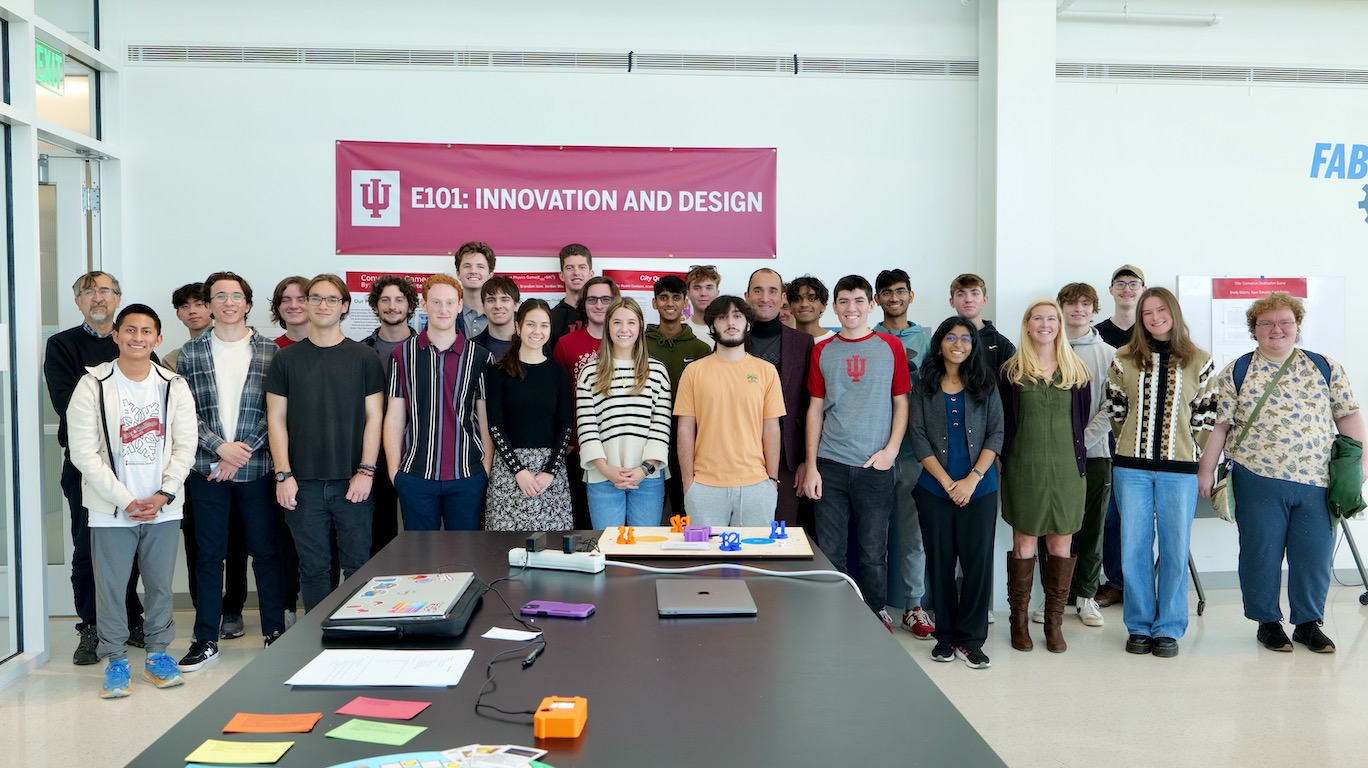
How do you make learning fun, innovative and enriching?
How do you take intelligent systems engineering skills to design and create games for elementary students?
What does that have to do with Strong Women, Deep Sea, a Shoe Sprint and more?
Welcome to the final presentations for the Luddy School of Informatics, Computing, and Engineer’s Intelligent Systems Engineering's E101 Innovation and Design Class. Thirty-two teams, representing more than 100 ISE students created games in a collaboration with Adam Maltese, a School of Education professor, and 10 public school teachers as clients from Indiana and the renowned Armstrong Teacher Education Award.
Bryce Himebaugh, Luddy School associate clinical professor of engineering and one of three class instructors, said the goal was to introduce students to engineering design, and take them through a real project with a real customer, in this case a teacher.
In the class, students learned skills such as how to program in Python, how to work with a Raspberry Pi (a small single-board computer), how to model 3D objects and how to use fabrication tools such as laser cutters and 3D printers to create their games.
“Use all those tools, learn the engineer design process to talk to their customer, refine a problem statement, and break that down into objectives and constraints,” he said. “Take what they learned and apply it to a real engineering design project.”
Consider the trivia-based board game, Here’s to Strong Women. The game was created by ISE freshman Leigha Trusty, sophomore computer science major Anshu Roja Selvamani and freshman psychology major Jordan Carey.
Carey said the game promotes and honors strong women in history, such as entertainer Taylor Swift, Olympic gymnast Simone Biles, pro tennis player Maria Sharapova, singer Carol King and Princess Diana. They worked with a teacher at an all-girls school in New York City.
“The point was to teach her students all about these strong women and what they’ve accomplished,” Carey said.
Selvamani said the client wanted to emphasize women who were not household names “because she wanted to educate the students.”
“She wanted women who are under-represented, a diverse category of women from different races and profiles. She wanted to make it super inclusive for everybody.”
Trusty said they used a lot of the skills learned in class to laser cut the game’s border and print game pieces. She added that their research turned up many successful women, even in an art world that was once dominated by men such as Michelangelo and Leonardo DaVinci.
“Some of them are not as well known, but have done great things,” she said.
Olgun Sadik, an ISE lecturer and class instructor, said what made this project special was that it targeted the United Nation’s 17 sustainable development goals in areas such as poverty, climate action and environment.
He said specific topics were chosen based on talks with clients. They helped teams create game protypes for elementary and middle school students ages 7 to 12.
“They needed to create a learning game, an educational game and a purpose,” he said. “The games had to include a mission related to UN sustainable goals.”
The game Shoe Sprint, which targeted middle-school students, addressed those sustainable goals. Shani Desali (freshman neuroscience), Zoe Arvanitis (freshman undecided) and Edred Assiz (freshman ISE) devised a four-player board game featuring beginner, intermediate and advanced levels of difficult. They used a laser to cut a board game and 3D fabrication to produce eight pieces and shoes for players to collect.
With the help of their client, a science teacher, Desali said they picked a shoe theme because of strong student shoe interest. Each player is a business producer.
“We had to implement the idea of responsible production and consumption,” she said.
Arvanitis said students had to answer chemistry questions to determine who could get the most shoes. It tied into the UN’s goal of consumption and production.
“We wanted to make it educational, fun, realistic and practical. The game board had to be durable, and you had to be able to complete the game in 45 minutes.”
Azziz said the teacher provided invaluable feedback in designing the game.
“Once we figured out what we wanted to do, it was good.”
Mary Loveless, an ISE faculty lecturer and class instructor, said students not only learned technical skills, but also intangible skills such as collaborating with a client as well as presenting and writing technical material.
“They got to show off all their hard work. I loved seeing them work through this process. It’s process and product.”
In the game Deep Sea Division, Finnian Meyer (freshman computer science), Andrew Hugo (freshman computer science) and Chase Martin (freshman ISE) created a game about division based on an underwater theme.
They came up with a Raspberry Pi case that featured coral, seaweed and schools of fish designs.
Meyer said the underwater theme was relatable to students.
“It was important that we didn’t come at it just from the perspective of math, but still wanted them to know that division is extremely important in all areas of math. You need it for pretty much every class.”
He added the biggest challenge was the game coding.
“Programming was incredibly difficult when you’re first learning it,’ he said. “It took a lot of mental energy.”
The game features three levels of difficulty to accommodate “people who are great at math and don’t need any practice, and those who struggle and need all the help they can get.”

